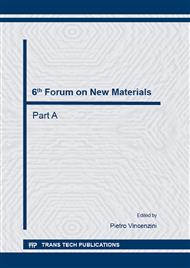[1]
A.K. Padhi, K.S. Nanjundaswamy, J.B. Goodenough, Phospho-olivines as positive-electrode materials for rechargeable lithium batteries, J. Electrochem. Soc., 144, (1997) 1188-1194.
DOI: 10.1149/1.1837571
Google Scholar
[2]
S.L. Yang, M.J. Hu, L.J. Xi, R. G Ma, Y.C. Dong, C.Y. Chung, Solvothermal synthesis of monodisperse LiFePO4 micro hollow spheres as high performance cathode material for lithium ion batteries, Appl. Mater. Interfaces, 5, (2013) 8961-8967.
DOI: 10.1021/am401990b
Google Scholar
[3]
Y.Z. Zhang, L. Chen, J.K. Ou, J. Wang, B.Z. Zheng, H.Y. Yuan, Y. Guo, D. Xiao, Improving the performance of a LiFePO4 cathode based on electrochemically cleaved graphite oxides with high hydrophilicity and good conductivity, J. Mater. Chem. A, 1, (2013).
DOI: 10.1039/c3ta10736a
Google Scholar
[4]
Y.H. Huang, J.B. Goodenough, High-rate LiFePO4 lithium rechargeable battery promoted by electrochemically active polymers, Chem. Mater., 20, (2008) 7237-7241.
DOI: 10.1021/cm8012304
Google Scholar
[5]
C.B. Zhu, Y. Yu, L. Gu, K. Weichert, J. Maier, Electrospinning of highly electroactive carbon-coated single-crystalline LiFePO4 nanowires, Angew. Chem., Int. Ed. 50, (2011) 6278-6282.
DOI: 10.1002/anie.201005428
Google Scholar
[6]
J.L. Yang, J.J. Wang, Y.J. Tang, D.N. Wang, X.F. Li, Y.H. Hu, R.Y. Li, G.X. Liang, T.K. Shamb, X.L. Sun, LiFePO4-graphene as a superior cathode material for rechargeable lithium batteries: impact of stacked graphene and unfolded grapheme, Energy Environ. Sci., 6, (2013).
DOI: 10.1039/c3ee24163g
Google Scholar
[7]
Y.S. Hu, Y.G. Guo, R. Dominko, M. Gaberscek, J. Jamnik, J. Maier, Improved electrode performance of porous LiFePO4 using RuO2 as an oxidic nanoscale interconnect, Adv. Mater. 2007, 19, 1963-(1966).
DOI: 10.1002/adma.200700697
Google Scholar
[8]
G. Yang, C.Y. Jiang, X.M. He, J.R. Ying, F.P. Cai, Preparation of V-LiFePO4 cathode material for Li-ion batteries, Ionics, 18, (2012) 59-64.
DOI: 10.1007/s11581-011-0620-9
Google Scholar
[9]
J. Jiang, W. Liu, J.T. Chen, Y.L. Hou, LiFePO4 Nanocrystals: liquid-phase reduction synthesis and their electrochemical performance, Appl. Mater. Interfaces, 4, (2012) 3062-3068.
DOI: 10.1021/am300418p
Google Scholar
[10]
B. Kang, G. Ceder, Battery materials for ultrafast charging and discharging, Nature, 458 (2009) 190-193.
DOI: 10.1038/nature07853
Google Scholar
[11]
J. Su, X.L. Wu, C.P. Yang, J.S. Lee, J. Kim, Y.G. Guo, Self-assembled LiFePO4/C nano/microspheres by using phytic acid as phosphorus source, J. Phys. Chem. C, 116, (2012) 5019-5024.
DOI: 10.1021/jp212063e
Google Scholar
[12]
A.M. Cao, J.S. Hu, H.P. Liang, L.J. Wan, Self-assembled vanadium pentoxide (V2O5) hollow microspheres from nanorods and their application in lithium-ion batteries, Angew. Chem. 117, (2005) 4465-4469.
DOI: 10.1002/ange.200500946
Google Scholar
[13]
F.F. Cao, Y.G. Guo, L.J. Wan, Better lithium-ion batteries with nanocable-like electrode materials, Energy Environ. Sci., 4, (2011) 1634-1642.
DOI: 10.1039/c0ee00583e
Google Scholar
[14]
X.Q. Ou, L. Pan, H.C. Gu, Y.C. Wu, J.W. Lu, Temperature-dependent crystallinity and morphology of LiFePO4 prepared by hydrothermal synthesis, J. Mater. Chem., 22, (2012) 9064-9068.
Google Scholar
[15]
K.F. Hsu, S.Y. Tsay, B.J. Hwang, Synthesis and characterization of nano-sized LiFePO4 cathode materials prepared by a citric acid-based sol-gel route, J. Mater. Chem., 14, (2004) 2690-2695.
DOI: 10.1039/b406774f
Google Scholar
[16]
C.W. Sun, S. Rajasekhara, J.B. Goodenough, F. Zhou, Monodisperse porous LiFePO4 microspheres for a high power li-ion battery cathode, J. Am. Chem. Soc. 133, (2011) 2132-2135.
DOI: 10.1021/ja1110464
Google Scholar


